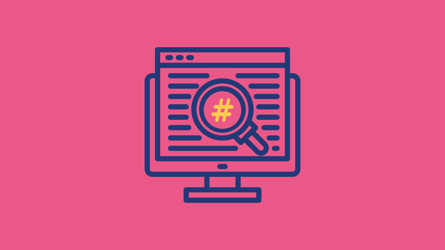Since the dawn of time, we’ve used images to express ourselves. From cave painting to emoji, we share our emotions - fear, love, hate, anger, pleasure…
We share billions of images online. Often, these images contain brand logos but don’t tag the brand. Crucially, the intelligence they provide is valuable to brands. So capture it.
For instance… You’re sponsoring a sports event. Your logo will be everywhere - t-shirts, pitch-side banners, literature, food containers, etc.
If you’re hoping to increase brand awareness and recognition, how do you measure your success?
Is your logo visible in social media posts shared from the event? What’s the context - negative or positive? Is your logo visible?
Image recognition data shows a change in brand visibility, by finding posts shared during and post-event. More consumers engaging with your brand is a strong indication that you have an ROI from your sponsorship.
There are over five billion images taken every day. This means more exposure to image data than ever before.
Social media users have fully embraced the concept of sharing photos alongside or in place of text. You need to find shared images including your brand logo but no brand mention in real-time. This will monitor-
- A positive image, and you've found yourself some great user-generated content
- A negative image, and you need crisis management. Quick.
This explosion of “a picture paints a thousand words” explains the growth of video and photo-based social media…
- Facebook - 3.065 billion monthly active users as of Q4 2023
- Instagram - 2 billion monthly active users as of December 2021
- Snapchat - 414 million daily active users in Q4 2023
- TikTok - 1 billion monthly active users
Being able to identify, analyze, and exploit this growing trend is essential to protect and promote your brand. With the future of digital marketing dominated by visual data - image recognition technology has to exist. Without it, you're missing out on a whole heap of image data.
This data shows where people use your product, i.e.
- Drinking Coca-Cola with pizza
- Eating pizza on the terrace
- Pizza delivery or eat-in
It shows how consumers are using your product and if they want features that you're not providing, but your competitors are.
So much data!
I'm going to list some awesome image recognition tools. They have different features, capabilities, and prices. I've included Talkwalker's proprietary AI-enabled image recognition technology because it's the best image recognition software on the market. Accuracy levels and ease of use, ensure it's the industry leader.
What is image recognition?
Definition of image recognition technology? A computer using its 'eyes', as you would use yours.
Driverless cars, facial recognition, and accurate object detection in real-time. Without image recognition powered by machine learning models, none of these things would exist.
Image recognition is the creation of a deep neural network that processes all the pixels that make up an image. These convolutional neural networks are fed multiple images of objects to learn and recognize similar objects.
For instance... Artificial intelligence - AI - is trained on images of shoes. The AI learns what images of shoes should contain - laces, heels, buckles, studs, etc. If shown an elephant, the AI compares all the pixels in the image to all its images of shoes. Finding no or few matches, the AI would recognize the object as an elephant.
Many businesses adopt deep learning, AI-powered image recognition software. These include pharma and healthcare, security, fashion & beauty, automotive, and e-commerce. Let's look at some.
Here are examples of object detection tools you’ve heard of, but maybe didn't know used image recognition technology...
- Driverless cars combine image recognition software and computer vision to recognize vehicles, pedestrians, and road signs.
- Price comparison sites use photographs uploaded by consumers of something they're interested in buying. Use an app like Google Shopper to find prices and nearby stores.
- Google Image Search works when users share an image or URL. The search engine then displays all instances where the image appears on the web.
- Is it a dog or not? Not Hotdog - for those times when you need to know if something is a... hotdog.
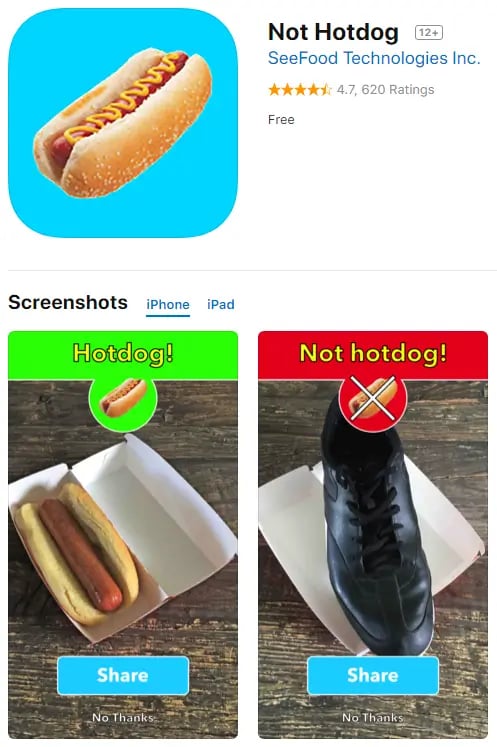
The image on the left is a hotdog.
Why should I use image recognition?
The data from image recognition tools helps in
- Understanding your customers and their interests
- Creating targeted ads for specific groups
- Protecting your trademark and brand identity
Imagine being able to provide Facebook ads based on people’s individual preferences and passions. Think of the PR crisis you can dodge when you catch someone using your logo on fake goods.
Image recognition tools -
- Help you better understand your customer base - buying behavior, expectations, and issues
- Understand what would help you break into a new market
- Ensure that no one is misusing your logo
- Analyze the true reach of your marketing
It provides the digital consumer insights you need and opens your eyes to new possibilities that you would have missed. A recognition system is the compass every business needs to navigate the complicated terrain of a modern digital world.
This post gives you some insight into the various image recognition tools available. And helps you decide which is best for your business and your brand.
What can image recognition tools do?
Image recognition tools can recognize, analyze, and interpret digital images. Don't take this the wrong way, but they're so much more efficient than you and your team.
They'll save you time and money. Image recognition tools can sort through countless images and quickly return data for your brand.
Benefits of using image recognition
Image recognition involves recognizing scenes and objects, and detecting logos in an image, using machine learning. Achieved by comparing an object with stored training data.
Avoid trademark abuse
Image recognition tools protect your brand from trademark and copyright abuse. Your logo and reputation are your most valuable assets. Misuse of them will damage your brand image. Losing customers and trust.
Use images your audience love
Track the engagement of your visual posts to determine how popular they are. Does your audience prefer photos, infographics, illustrations, vector images? Choosing visual branding that resonates will persuade and convert consumers.
Find untagged comments
It may be a positive comment or a negative one. Regardless, you need to find it. Either to say thanks, or to apologize and fix an issue.
As I've already said, consumers don’t always tag the brand they’re talking about. They share a video or a photo with your product in shot. Image recognition tools will find these untagged comments, so you can protect your reputation and potentially, find brand advocates.
What are the types of image recognition?
Image recognition is used for surveillance, security, image retrieval, machine inspection, and automated vehicle systems. Including…
- Optical character recognition - OCR
- Tracking objects
- Facial recognition
- Self-driving cars
- Emotion detection
- Medical imaging
Image recognition use cases
Thanks to intuitive platforms like Talkwalker, AI-enabled image recognition is no longer a tool restricted to IT experts. The model training ability means that industries across the board can meet their specific requirements.
Digital Marketing
Use AI-enabled image recognition to collect consumer insights. Include sentiment analysis for a full understanding of how consumers feel and think about your brand and products. Even if they don’t tag your brand.
Find the best influencers for your brand by looking at what they’re sharing on their accounts. The images they’re posting, and the brands they’re promoting.
Train an image recognition tool to find inappropriate images - nudity, weapons, or violent acts. Employ content moderation to maintain your brand guidelines.
To measure brand awareness and visibility, image recognition tools can track how often your logo appears in images.
Retail
In grocery stores, image recognition at check-outs can identify products, such as fruit and veg. Calculating the objects and the quantity.
To improve stock management, image recognition tech can scan shelves to
- Find those that need restocking
- To organize misplaced items
- Track use-by-dates
Image recognition also came to the rescue of consumers looking to buy clothes.
Smart mirrors - digital mirrors, smart displays, visual mirrors - used in brick-and-mortar stores know when a person stands in front of it. It suggests clothes based on what the consumer is wearing. The mirror then shows them different new outfits. The shopper can choose different styles, colors, etc.
Retailers - H&M, ASOS, and more - use visual search to save consumers time searching websites. Visual search allows shoppers to upload an image of an item to the retailer's website, and find similar items.
Security
Home security systems stepped up with the introduction of image recognition technology.
While many homes have security systems, motion detectors aren't very discerning.
Image recognition technology overcomes this problem with facial recognition software. With some systems sending live video to your chosen device.
Causing controversy, many police forces have also adopted facial recognition technology to monitor crowds when looking for suspects.
Automotive
Let's talk about autonomous cars. On the one hand, a scary prospect, driverless cars have a place in the world.
Video cameras to monitor traffic lights, road signs, vehicles, and pedestrians. Radar - radio detection and ranging - and lidar - light detection and ranging - sensors, are driving us closer to driverless cars.
The benefits are obvious - minimize accidents, reduce emissions, and ease congestion. Driverless cars don't break the rules of the road, don't get distracted, and react quickly.
Farming
Image recognition software in the agricultural industry helps -
- Identify when and which crops need watering
- Find insect infestations
- Discovers diseases
Faster and more effective than doing it manually, you can rescue crop and save money.
Healthcare
Hospitals can diagnose tumors, bone fractures, tissue anomalies, and some types of cancer quickly with image recognition software. For instance, you can scan birthmarks and moles for skin cancer. Any issues are further tested.
Check out Facebook's Automated Alternative Text feature and LookTel for image recognition tools developed to help visually impaired people.
Manufacturing
With increasing demand comes mass production. From car parts to bars of soap, safety and quality are essential to ensure the safety of consumers. Image recognition tools create an image database of the correct product, and find defects. For instance, items are all the same size, color, etc.
Image recognition tools
Call me biased, but I'm going to jump straight in with what I consider to be the best image recognition tool on the market. Talkwalker's Consumer Intelligence Platform, powered by our Blue Silk™ AI.
Talkwalker | Proprietary image recognition technology
Talkwalker's image recognition and object detection searches a database of over 30,000 logos, scenes, and objects. Giving you access to virtually any company information you could need.
Beyond the sheer volume of imagery it can recognize, it searches both text and images. And includes OCR to find brand mentions within text in images.
Talkwalker's proprietary image recognition technology adds to your existing brand knowledge. And helps you use those social data insights as you continue to grow your business.
Not every brand mention includes the brand name in the message. Talkwalker’s AI-enabled image recognition technology will identify a brand’s logo, text, or not…
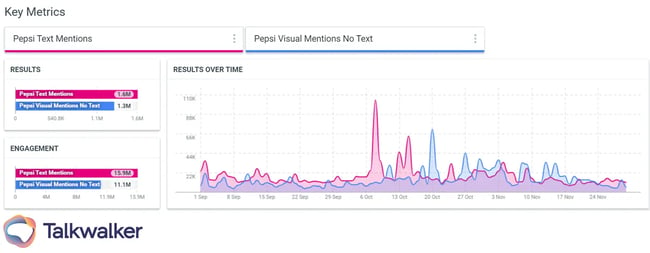 Over 3 months, we found 1.6 million mentions of Pepsi. And found 1.3 million Pepsi logos in posts that didn't mention Pepsi. Without image recognition, these extra mentions would have been missed. Talkwalker Social Listening
Over 3 months, we found 1.6 million mentions of Pepsi. And found 1.3 million Pepsi logos in posts that didn't mention Pepsi. Without image recognition, these extra mentions would have been missed. Talkwalker Social Listening
Do you know how your products are being used?
— humans without context (@HumansNoContext) November 3, 2023
You need to see who is sharing your brand. And how.
How many mentions of your brands’ logos are you missing by only tracking text mentions?
Google Reverse Image Search | Search with image
You've found the perfect image, but it's the wrong size. You need an image that's similar to the one you have.
You need Google Reverse Image Search!
As the name suggests, this image recognition tool allows you to upload an image and perform a search with it.
You're searching with an image, rather than words. Cool!
This tool is just as intuitive as a typical text-based Google search and it retains the power of Google.
Examples of how you could use this tool include...
- You need to find the source of an image so you can credit it correctly
- Searching for improper use of an image that you own - trademark infringement
If an image exists online, Google Reverse Image Search will help you find what you're looking for.
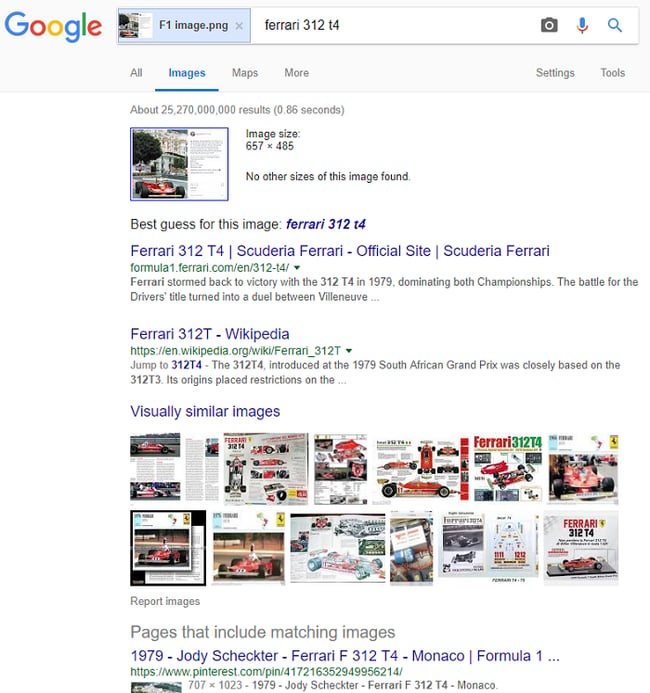 Uploading the above screenshot from the F1, brings a heap of image recognition data.
Uploading the above screenshot from the F1, brings a heap of image recognition data.
Google API Cloud Vision | Analyze images
Google API Cloud Vision allows you to analyze images in many ways. From recognizing explicit content to detecting emotional cues in faces. With such a wide suite of features, it's a versatile tool adaptable to meet your specific needs.
Beyond its flexibility, this image recognition tool carries with it the power of Google and all the name implies. This means it's one of the most powerful tools you'll find.
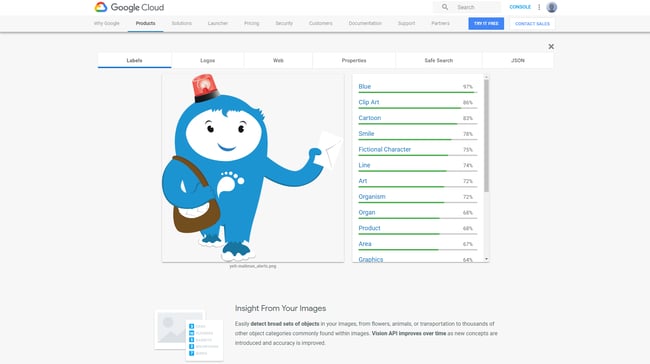 Image recognition tool with the power of Google!
Image recognition tool with the power of Google!
Amazon Rekognition | Image & video recognition tools
Another big name in the web world, Amazon brings an image recognition tool to the table with unique offerings.
Amazon Rekognition not only analyzes still images, it can also provide insight into videos.
It's a highly technical program capable of...
- Object, scene, and activity detection - playing football, bike, beach, city, etc.
- Facial recognition - identify a person in a photo or video
- Facial analysis - smiling, eyes open, glasses, beard, gender
- Pathing - e.g. the movement of athletes during a game for post-game analysis
- Unsafe content detection - identify unsafe or inappropriate content in images and video
- Recognizing celebrities - identify the stars from your video and image libraries
- Text in images - detect and recognize text such as street names, captions, product names, car number plates
Amazon assures users that the constantly-learning image recognition tool is intuitive to integrate and use.
A perk of Amazon Rekognition is that you only pay for data you use. This means there are no minimum fees in place. It allows you to use the program as you see fit and access all the benefits of a powerful system without breaking the bank.
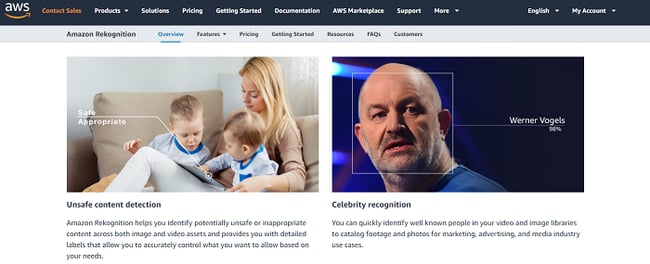 Unsafe content detection and celebrity recognition.
Unsafe content detection and celebrity recognition.
Talkwalker | Video analytics
Amazon Rekognition isn't the only video analysis tool that can analyze images and videos. Talkwalker's also includes video analytics technology...
Is your brand's logo missing in action?
Talkwalker's AI-powered video recognition technology lets you capture the value of your brand in action.
Using our video analytics technology alongside image recognition finds 3x the amount of brand mentions. Regardless of whether it includes your brand in the written content.
In our vast database, our visual recognition technology has access to over 30,000 logos, objects, and scenes.
Campaign engagement up by 50%
Exploit user-generated content to drive brand awareness. UGC can improve campaign engagement by 50%, increase email click-through by 73%, and conversions by 29%.
Crisis management
Protect your most valuable asset - your logo.
Use visual analytics to find every mention of your logo, be it in videos or photos. With or without a text mention of your brand.
- Protect your trademark and brand reputation
- Find counterfeit products and logo abuse
- Catch a negative issue before it becomes a full-blown PR crisis
Clarifai | Search for similar images
This image recognition tool lets you search for images using other images.
For instance, you might want to find images based on similarities, and words can only take you so far.
If you describe an image to a search engine, it’s unlikely you’ll find exactly what you’re looking for. The Clarifai image recognition tool does the work for you. It helps you to find similar images simply by choosing photos and telling the tool what to do.
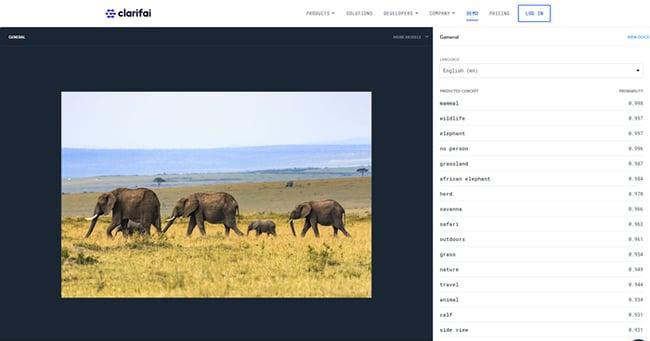 The tool analyzes a photo and recognizes mammal, wildlife, outdoors, grass, animal, herd, ivory... elephant!
The tool analyzes a photo and recognizes mammal, wildlife, outdoors, grass, animal, herd, ivory... elephant!
LogoGrab/Visua | Logo and mark recognition
LogoGrab is now Visua. It acts as a bridge for companies wanting to cross into the next era of marketing and consumer engagement.
Designed for tech companies, ad agencies, and brands, Visua focuses on engagement on mobile platforms. Making it an ideal image recognition tool for those looking to get the most out of their social media presence.
Visua boasts that their tool integrates seamlessly into most pre-existing platforms.
IBM Image Detection | Trainable image recognition
IBM - a giant in the tech world - is at the forefront of developing cutting-edge technology.
Its image recognition tools are some of the best out there. One of the main advantages of IBM Image Detection is how trainable it is. They provide a highly-customizable platform tweaked to perform virtually any task you need.
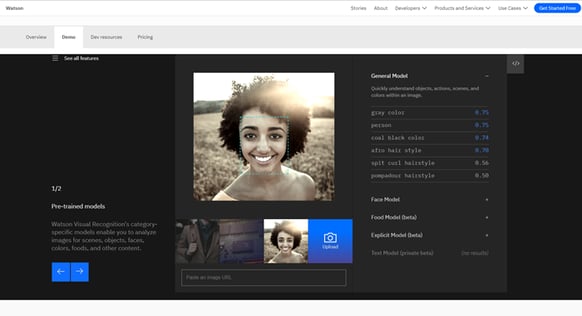
Analyze images from scenes, objects, faces, colors, foods, and other content.
Imagga | Categorize images
Imagga’s image recognition tool provides multiple automated options. These include sorting, organizing, and labeling images based on category, color, tag or custom input. This means you have multiple built-in options, but can also develop to meet your specific needs. The duality of Imagga allows it to fit any circumstance or skill level.
Ideal if you need a way to keep things ordered without burning valuable company time. Or when you need to ensure no explicit content shows up on your page. Imagga has a tool for you, and if they don’t, you can make one!
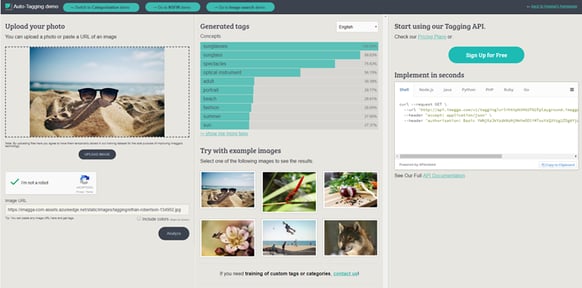
All-in-one image recognition solutions for developers and businesses.
CloudSight | recognize, categorize, understand
While some tools focus on highly specialized execution and application, others try to maximize convenience while retaining impressive functionality. For those looking for an easy-to-use and self-described “effortless” tool, CloudSight is perfect.
This image recognition tool streamlines the process of image classification, recognition, and categorization. It allows you to take a nearly hands-off approach to the use of visual elements.
It could mean...
- Allowing the program to write a natural-sounding caption
- Integrating imagery seamlessly into your online retail space
- Uncovering the key material in your video content
CloudSight is intuitive without sacrificing any of the functionality you would expect from a top image recognition tool.
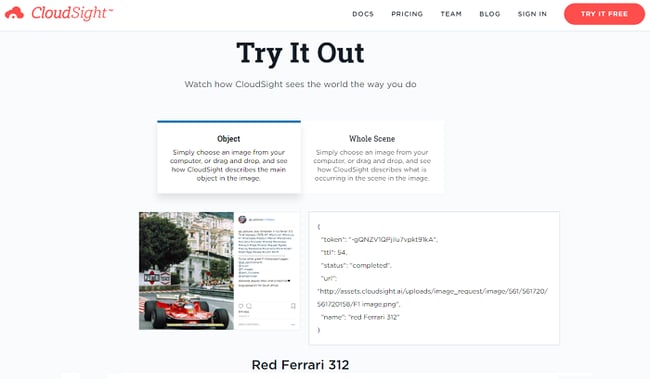
Awesome!
EyeEm | Evaluate photo aesthetic rating
For those of you who love photography and its potential, EyeEm’s image recognition ws the ideal tool. Especially for those using social media platforms.
With automatic tags and captions, it tapped into the tags that best fit your images, to increase exposure. EyeEm went above and beyond this, by using image recognition to evaluate a photo’s aesthetic rating.
The brand still exists but focused on stock photography.
Facebook | Automatic Alternative Text
Alternative text is for anyone who has visual impairments and uses a screen reader or text-to-speech technology. When you add an image to a blog post or upload to social media, you should add alt text. It describes the image for people with visual impairments that use screen readers, and search engines can understand.
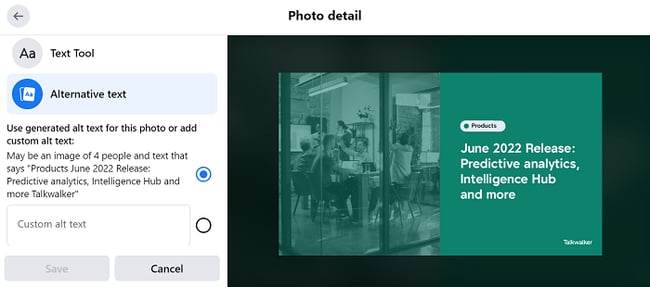
Facebook Automated Alternative Text using image recognition technology.
In 2016, Facebook introduced its AAT - automated alt text - feature. The process uses image recognition to find basic characteristics in an image and translate it into alt text.
LookTel | Recognition app for the visually impaired
A suite of assistive smartphone applications for people with visual impairments. The real-time technology helps people scan and recognize multiple objects, including money, packaged goods, store fronts, soda cans...
Real-time recognition technology enables users to scan and instantly recognize objects.
The LookTel Money Reader and LookTel Recognizer are currently available on iPhone, iPod Touch, iPad, and Macs, with more apps on the roadmap.
Find your logo online
Regardless of what you want from an image recognition tool, there is an ideal one for you and/or your brand.
Image recognition technology will benefit any business, regardless of size, product, or market. From maximizing brand recognition to expanding markets via social media platforms. Image recognition is key to navigating our information-heavy world.
What'll make you stand out from the mass of data? What elevates your brand above that of your competitors? How can you best identify the ideal market for what you have to offer, and then reach it in a targeted and highly effective manner? How can you ensure that your brand identity isn't abused?
The answer is image recognition.
Image recognition is a key part of Talkwalker’s Social Listening. Now you can track your brand performance online, across social media posts, images, videos, audio, and more.
Click below to see what else it can do.



